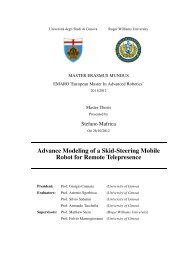SECCM Assessment Plan - Roger Williams University
SECCM Assessment Plan - Roger Williams University
SECCM Assessment Plan - Roger Williams University
You also want an ePaper? Increase the reach of your titles
YUMPU automatically turns print PDFs into web optimized ePapers that Google loves.
Table 3.12a Sample of Outcomes Worksheet<br />
COMSC110 Introduction to Computer Science & Lab<br />
Outcome a: demonstrated capabilities in abstraction, algorithm analysis, computer theory, computer organization and programming<br />
language concepts.<br />
At the conclusion of this course, students are expected to: Covered <br />
Analyze and explain the behavior of programs involving various programming constructs<br />
Y<br />
Discuss the importance of algorithms in the problem solving process<br />
Y<br />
Create algorithms for solving problems<br />
Y<br />
Discuss the representation and use of data types and structures<br />
Y<br />
Implement user-defined data types and structures<br />
Y<br />
Compare alternative implementations of data structures with respect to performance<br />
N<br />
Choose the appropriate data structure for modeling a problem<br />
N<br />
Use big O, omega, and theta notation to give asymptotic upper, lower and tight bounds on time and space complexity of<br />
algorithms<br />
N<br />
Implement greedy, and divide-conquer algorithms to solve appropriate problems<br />
N<br />
Discuss computational efficiency of sorting, searching, and hashing algorithms<br />
N<br />
Develop deterministic and nondeterministic finite state machines<br />
N<br />
Explain how some problems have no algorithmic solution<br />
N<br />
Determine a language’s location in the Chomsky hierarchy (regular, context-free, enumerable, etc)<br />
N<br />
Describe the basic building blocks of computer architecture<br />
Y<br />
Summarize how instructions are represented at the machine level and in the context of a symbolic assembler<br />
Y<br />
Explain the concepts of a memory hierarchy<br />
Y<br />
Explain the process of interrupt processing in IO and data transfers<br />
N<br />
Describe the evolution of operating systems from batch systems to multi-user systems<br />
N<br />
Compare and contrast various ways of structuring an operating system such as object-oriented, modular, micro-kernel, layered<br />
N<br />
Explain the different states a task passes through and the data structures required for managing task<br />
N<br />
Compare and contrast various scheduling algorithms for operating systems<br />
N<br />
Evaluate trade-offs in terms of memory size and processor speed<br />
N<br />
Evaluate tradeoffs between different programming paradigms<br />
Y<br />
Describe the phases of program translation from source code to executable code and the files produced by these phases<br />
Y<br />
Explain how abstraction mechanisms support the creation of reusable software components<br />
Y<br />
Other (explain)<br />
N<br />
57
















